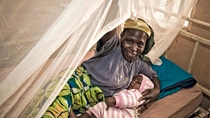Agriculture
Building A Stronger Line Of Defense Against Malaria
The New Nets Project
The fight against malaria takes persistence, partnership and innovation. With progress stalling, the New Nets Project is a ground-breaking initiative to bring forward new tools to eradicate the disease. BASF’s innovative Interceptor® G2 insecticide-treated mosquito net is an essential part of the project.
For much of the past two decades, the fight against malaria has been going in the right direction. A global effort by public health bodies, NGOs and many other organizations has seen cases of malaria falling year on year. However, in 2017, the numbers started to increase again. Yet, the goal of eradicating malaria is still achievable with the help of innovative new tools.

In the fight against malaria, long-lasting insecticide-treated mosquito nets have played a vital role. They protect the individual and, crucially, the community by killing mosquitos and stopping them from spreading the disease further.
Achim Reddig, who leads BASF’s global public health business, has seen for himself the impact nets can have in South America. “Nets not only reduce the incidence of malaria; they also improve lives by enabling people to go to work and children to attend school,” he says.
However, mosquito populations are becoming resistant to pyrethroids, the only class of insecticide used for bed nets since the 1980s. There is now an urgent need to develop and test new tools. The New Nets Project aims to accelerate this process by working to build the evidence around a new generation of nets treated with different types of insecticides.
The New Nets Project is co-financed by the Global Fund to Fight AIDS, Tuberculosis and Malaria and Unitaid, who are each investing US$33 million, along with other financial partners including the U.S. President’s Malaria Initiative and the Bill & Melinda Gates Foundation. A consortium of experts, led by the Innovative Vector Control Consortium (IVCC), has been appointed to implement the project.
BASF’s Interceptor® G2 mosquito net is one of the nets involved. Unlike other bed nets, Interceptor® G2 is treated with two active ingredients – the pyrethroid alphacypermethrin, and chlorfenapyr. Chlorfenapyr is a new class of insecticide that BASF has repurposed for public health use. It has a unique mode of action, meaning that it works against mosquitoes that are resistant to pyrethroids.
Progress on fighting malaria is stalling. We think insecticide resistance may be one reason for this. We therefore felt it was important to look at nets treated with insecticides to which resistance hasn't yet developed. The New Nets Project will fill some of the evidence gaps around these news tools, ensuring we are ready to scale up distribution rapidly if and when the WHO make a policy recommendation supporting their general use.
In 2017, after eleven years of research and development working closely with IVCC, the London School of Hygiene and Tropical Medicine, and other bodies, Interceptor® G2 was included on the WHO List of Prequalified Vector Control Products for use in malaria prevention and control
This means that the new net is proven to control mosquitoes effectively, poses no hazard for people using it and may already be procured by health ministries. However, it has a higher price, reflecting the fact that it has two active ingredients. Before health ministries can roll it out at scale in areas of resistance, epidemiological trials are needed to prove it brings additional public health value by reducing more cases of malaria than conventional pyrethroid-only nets.
Under the usual evaluation procedures requested by WHO, epidemiological trials are complex, costly and take many years. In the meantime, resistance in the mosquito population is growing, rendering the key tool in the fight against malaria less effective. There is therefore a sense of urgency in the malaria fighting community. That’s why the New Nets consortium has come together to drive forward testing and piloting.

In 2018, 40,000 Interceptor® G2 nets were distributed to villages in Tanzania, East Africa, for randomized control trials funded by the UK government and the Wellcome Trust. Under the New Nets Project, a second trial will begin in Benin, West Africa, in 2020.
The level of malaria reduction achieved by the new nets will be compared with the performance of conventional nets in the same trial. The hope is that the results will show that these new tools can take the fight against malaria to the next level.
We need to intensify efforts in the highest burden countries and learn how to target new malaria tools – that means understanding which tools to use where and which will yield the most value for money and impact. Our aim is to speed up the process by establishing the value of next generation products.
In parallel, a further two million Interceptor® G2 nets are being delivered to Burkina Faso in 2019 for an operational pilot to trial effectiveness and public health value. This first targeted campaign will be followed by campaigns in Rwanda, Mali and Mozambique.
“The New Nets Project will get Interceptor® G2 out to regions where it is most needed, where resistance is growing, and at the same time help push it through the last mile of the WHO process,” says Reddig. “The objective is to make much-needed innovation available to the malaria community faster.”
The Interceptor® G2 nets are not intended to replace conventional nets but introducing them in a targeted way will help contain the growth of insecticide resistance and keep the less expensive conventional nets effective for longer.
By guaranteeing price levels and volumes, the New Nets Project also makes investment in future research more sustainable for BASF. “We are very pleased to be able to contribute toward this next phase of the fight against malaria,” says Reddig. “The generous support of the Global Fund and Unitaid and the expertise provided by IVCC and other partners means we can get the nets into the countries in the quantities required to save lives.”
Chemical companies’ efforts in this area can be transformational. Not many others have the know-how to develop new chemicals from scratch. With insecticide resistance on the rise, BASF’s efforts to innovate should be supported and commended.




